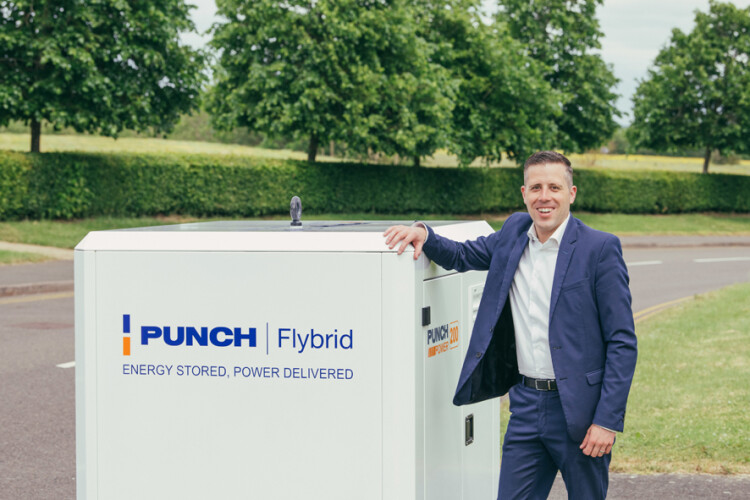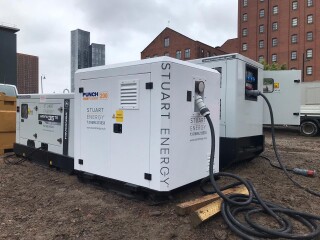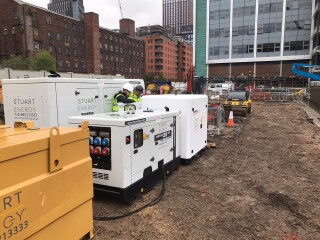This story begins in 2006 when the bosses of Formula 1 laid down the challenge to racing teams to develop hybrid power systems that recovered energy from regenerative braking systems. Flybrid was set up in 2007 as a boutique engineering company to bring hybrid power to auto sports exploiting the flywheel concept.
Flybrid was the first company with a kinetic energy recovery system (KERS) developed for Formula 1 racing. Furthermore, Flybrid provided the hybrid system for the first-ever hybrid racing car to compete at the 24-hour Le Mans race.
The concept was proven – but then the F1 engine rules changed, as they tend to, and its initial target market was gone. It has taken nearly 15 years but Flybrid’s technology has finally found its perfect market, powering duty-cycle construction machinery.
Earlier this year the Punch Power 200 (PP200), a flywheel energy storage module that couples an electric motor and variable frequency drive, entered the power generation market.
Just like F1 cars, construction site generators are inherently inefficient. Adding a flywheel to store kinetic energy, however, introduces efficiency, dramatically reducing fuel consumption. At the moment, fuel predominantly means diesel, which is set to more than double in price next April, when construction will no longer be allowed to use subsidised red diesel and will have to pay full duty on its fuel.
But whatever the fuel – diesel, HVO, solar power, mains electricity – Flybrid’s technology ensures that less of it is wasted.
Generators on construction projects are typically sized for peak loads. However, most of the time they run at low load factors, which results in poor fuel economy and high emissions. This is especially the case when running equipment like tower cranes, which oscillate between total idleness and full power.
By connecting a PP200 to the generator set, the flywheel load-levels the peak power that the generator set has to deal with. The Flybrid system delivers energy immediately at high power during an increasing load step and captures excess energy (in a spinning tube) during a decreasing load step.
Flybrid technology thus enables a smaller generator to be able to cope with these occasional surges of demand and take the place of a larger generator. With the red diesel rebate ending next spring there is suddenly a huge incentive for construction sites to use the least thirsty, smallest possible generator.
Flybrid has been through some changes of ownership since its early days, bought firstly by Torotrak in 2014, and then in 2018 by Guido Dumarey, owner of the Belgium-based Punch, who renamed it Punch Flybrid. However, its headquarters remain located alongside the Silverstone racetrack.
Tobias Knichel, who joined Flybrid in 2007 as a young engineer and was made managing director when Punch Group took over, joined the Re:Construction podcast in September where he explains the product and its development.
“We believe that it will become more and more unacceptable to waste energy and it doesn’t really matter where that energy is coming from, whether it is fossil fuel or HVO or even energy coming from renewable sources. If you waste it, it is becoming more and more unacceptable,” he says.
“Unfortunately for generators that are running on construction sites, often they are used quite dynamically and that means they waste energy.
“We developed our technology originally for Formula 1 racing… also an application where it is a very dynamic duty cycle. A Formula 1 car is constantly either accelerating as fast as it can or slowing down as fast as it can. So it uses fossil fuel (at the moment) to turn the chemical energy of that fuel into kinetic energy.
“When the driver stamps on the brakes it turns all of the kinetic energy into heat on the friction plates, and all that heat just gets lost. So that is a very inefficient way to use this really valuable fossil fuel.”
He explains that Flybrid began by looking at all of the possible methods that could be use to store energy, including loaded rubber bands, clockwork springs, hydraulic accumulators and chemical batteries before finally settling on flywheels.
“The flywheel principle is centuries old,” he acknowledges, “and has been used for pottery wheels for hundreds of years. Our innovation was to create a flywheel with a high power density and high energy density.
“In motorsport we had our flywheel spinning at over 60,000 rpm. So on the outside of the flywheel we had speeds of Mach 2, close to twice the speed of sound. Then we ran the flywheel in a vacuum to reduce the air friction and not have sonic booms. So the principle of the flywheel is very old but how you turn that into a product for the 21st century, this is where the innovation comes in.”
The technology and materials have been adapted for construction industry use, to make it affordable, but the motorsports background was key.
“We used motor sport because the environment is really nice – big budget, really fast pace, you get instant feedback of the technology advances that you make because you have a race almost every weekend, so either you make the car faster or you don’t. It is a really fast development process.”
After Formula 1, Flybrid looked at the mainstream automobile market, but batteries were always going to be a better energy storage device in that application. In comparative terms, personal cars are either parked or – bar the odd traffic light – are trundling along steadily. They do not have the dynamic work profile seen on construction sites or race tracks.
“For a flywheel to work in a regular car it would need to be the size of a house,” Knichel says. “Automotive is completely the wrong use of the technology. But if you need to cycle your energy storage very frequently and at high power, batteries tend to get quite hot and heat is wasted energy. Batteries have a life of maybe 2,000 to 4,000 cycles. For light-duty applications, that’s plenty – enough for a road car.

“In Formula 1 racing, where a race only lasts for two hours, you can get away with a lot of abuse of the energy storage system because after the race is over nobody cares any more. But if you stick it an excavator or a generator or a city bus, you have to have something that lasts.”
The flywheel used in the PP200 is designed for a life of more than 100,000 operating hours with more than 10 million full charge and discharge cycles.
“Flywheels tend to score really well on full life cycle emissions because there is not much energy required to create it, they save a really good amount of fuel and they are very easily recyclable. So applications with harsh duty cycles and long life is where the flywheel really scores,” says Knichel.
“A tower crane is a really good application because for a good chunk of its operations during the day the generator is mostly idling. But when the crane is lifting a load it suddenly gets a big kick to deliver power – suddenly, and straightaway. So, because of this, currently you need to fit quite a big internal combustion engine to deal with this big rise in power in order for the frequency and voltage not to drop.
“For a tower crane you typically have to size a generator two to three times bigger than the average load. This is where our product comes in.”
He continues: “We are acting a little bit as a parasitic load on the generator. We are taking fuel from the generator to turn that into electricity to drive an electric motor that spins our flywheel. At the outset, that doesn’t sound good because we are burning fuel to spin our flywheel,” Knichel admits.
“But because we have that energy in the flywheel we can then inject it exactly when it is required at high power rates and very quickly. And that means that we don’t need to run that massive generator that is three times bigger than the average generator. We can now run a generator that is optimised around the average load; and it operates in a really nice narrow operating band around its peak efficiency point. And when it gets a big kick from the tower crane and needs to deliver power, instead of having to suddenly jump up we are injecting energy from the flywheel. The flywheel deals with all the spikes.”
An initial 10 units were deployed to UK construction sites, via plant hire companies Sunbelt and Select and generator specialists Stuart Energy, John F Hunt and Abird. One of the first contractors to benefit was Bowmer & Kirkland at Manchester Metropolitan University.
Bowmer & Kirkland has an £82m contract to build a new science and engineering building at Manchester Metropolitan University. It has two Wolff tower cranes on site for which the manufacturer specifies a 300 kVA generator for each crane. Bowmer & Kirkland is using 150 kVA generators instead, with a Punch Power 200 unit attached to each, on hire from Stuart Power.
As a result, reveals group crane manager Dave Shooter, the contractor is saving 60,750 litres of diesel fuel per crane over the 45-week crane hire contract. That 121,500 litres of total fuel saving equates to 318,330 kg of carbon saved. In terms of hard cash, the savings have risen as the price of fuel has gone up. Subsidised red diesel was 55p per litre at the start of the hire, making a saving on fuel of £66,825.
Bowmer & Kirkland makes a further £18,000 saving by hiring smaller generators, although there is the additional cost of hiring the Punch Flybrid boxes. Shooter is reluctant to reveal the hire rate for the Punch Power 200 but says it comes to less than half the savings.
The higher the price of diesel, the more he saves. So when the construction industry loses access to red diesel in April 2022, the financial case will become even more overwhelming. Were Bowmer & Kirkland paying an unsubsidised £1.40 a litre on this job, for example, the Flybrid units would be saving it more than £170,000 in fuel costs. Just as importantly, the technology has never let him down. “It is a robust, reliable bit of kit. We did have a minor software problem once but it’s a remote access fix for them from Silverstone.”
As of October, Bowmer & Kirkland had 16 tower cranes up in the air around the country, of which five are supported by Flybrid boxes. “I’d have them on every crane if I could get them,” Shooter says.
Despite the impediment of a global shortage of microchips, the Punch group is stepping up production to meet anticipated demand ahead of the red diesel rebate disappearing.
“We have at the moment more demand than units, but we are quickly ramping up,” Knichel says. “We are quite small in the UK but we are part of a large organisation.”
Unsurprisingly, the bigger the generator, the bigger the savings. “The smallest generator that we have downsized is from a 200 kVA down to a 100 kVA generator,” Knichel says. “There we are saving around 9,000 litres of fuel per year.”
Stuart Energy director Lee Stuart says that although hiring a 150 kVA generator with a PP200 is more expensive that hiring a 300 kVA genset, this is rapidly paid off. And the longer the hire, the greater the benefit.
However, with bigger gensets the PP200 pays for itself just from the saving made by downsizing the generator. From day one money is saved by using less fuel, Knichel says.
Select Plant Hire connected a PP200 to a Terex Comedil CTL1600, a 66-tonne luffing tower crane, at one of its London projects for a month. Consequently, it was able to reduce the generator size from 800 kVA, specified by the manufacturer to cope with peak loads, to just 500 kVA. Over the course of the 213 operating hours it saved more than 1,300 litres of fuel (50% saving) and cut 3,478.5kg of CO2 pollution.
Over the course of a year, Knichel says, that equates to a saving of more than 30,000 litres of fuel and 80 tonnes of CO2.
On the back of this initial trial proving such a roaring success, Select, part of the Laing O’Rourke group, has formed a partnership with Punch Flybrid with a view to integrating the flywheel technology into the cranes and/or generators themselves.
Says Select managing director Alex Warrington: “It instantly generates substantial CO2 savings and saves significant costs of rental – it makes sense on every level.”
Got a story? Email news@theconstructionindex.co.uk





